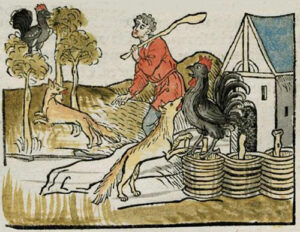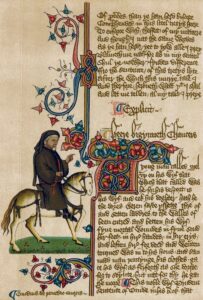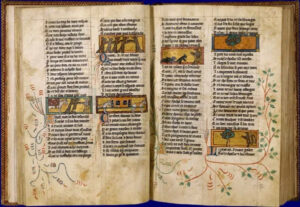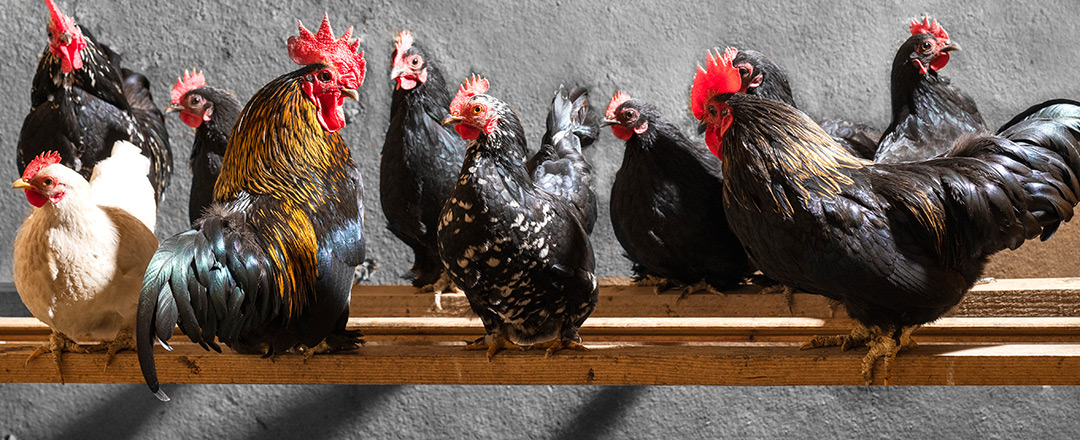The Chanticleer character emerged in Mediaeval times in at least one story. Although it is sometimes linked to the Aesop’s Fable story of the Fox and the Crow, it is thought to be of more recent origin. The Chanticleer appears as a major character in the Reynard the Fox story in the Middle Ages.
Jacques has two original paintings and a signed, limited edition triptych limited edition print featuring The Chanticleer:
“Three Chanticleers” Original Painting;
“Startled Chanticleer” Original Painting and
“Untroubled Chicken Chanticleer Triptych” Gallery-Size Limited Edition Signed Print
LEARN MORE ABOUT THE CHANTICLEER
 The Chanticleer and the Fox [*]
The Chanticleer and the Fox [*]
“Chanticleer and the Fox is a fable that dates from the Middle Ages. Though it can be compared to Aesop’s Fable of The Fox and the Crow, it is of more recent origin. The story became well known in Europe because of its connection with several popular literary works and was eventually recorded in collections of Aesop’s Fables from the time of Heinrich Steinhowel and William Caxton onwards. It is numbered 562 in the Perry Index. Because the tale of Chanticleer and the Fox enters into several mediaeval narrative masterworks, there has been considerable investigation into the question of its origin. It has also been asserted that the tale has developed out of the basic situation in Aesop’s fable of The Fox and the Crow. Early examples of the story are pithily fabular but towards the middle of the 12th century it appears as an extended episode of the Reynard cycle under the title “How Renart captured Chanticleer the cock” (Si comme Renart prist Chanticler le Coq). The work of which it was part was immensely popular and spread widely in translation.”
*Quotation above is taken directly from the website cited and is the property of that source. It is meant to inform the reader and to give credit where it is due.
 The Nun’s Priest’s Tale [*]
The Nun’s Priest’s Tale [*]
“The Nun’s Priest’s Tale”, one of the 24 stories in The Canterbury Tales by Geoffrey Chaucer, “The Nun’s Priest’s Tale” is based on the medieval tale of Reynard the Fox, common to French, Flemish, and German literature. The protagonist of this mock-heroic story is Chanticleer, a rooster with seven wives, foremost among them the hen Pertelote. Pertelote dismisses Chanticleer’s dream of being attacked and tells him to go about his business. A fox soon approaches and flatters him, recalling the exquisite song of Chanticleer’s father. The vain rooster is thus tricked into closing his eyes and crowing, only to be seized by the fox and carried off. As Chanticleer’s owners and the animals of the barnyard run after them, Chanticleer suggests that his captor yell to tell them to turn back. When the fox opens his mouth, the rooster escapes. The tale ends with a warning against flattery.”
*Quotation above is taken directly from the website cited and is the property of that source. It is meant to inform the reader and to give credit where it is due.
 The Book of Renart the Fox and Chanticleer the Rooster [*]
The Book of Renart the Fox and Chanticleer the Rooster [*]
“To find out why Chantecler is a favored name for roosters, we must first go back to the twelfth century and start with a fox. In those ancient days, minstrels traveled from town to town entertaining people with rhyming stories. And in medieval France, it seems that many of those stories had to do with a fox named Renart. Twenty-seven animal-centered fables, all written by different authors at different times, were assembled into an anthology called Le Roman de Renart (or The Book of Renart). These stories about Renart the fox and his interaction with other animals were updated throughout history and are still enjoyed by French children today. In one of the most popular tales, Renart had a run-in with a rooster whose name was Chantecler. But we’ll talk about the rooster in a minute. First let’s learn more about the fox.”
*Quotation above is taken directly from the website cited and is the property of that source. It is meant to inform the reader and to give credit where it is due.



